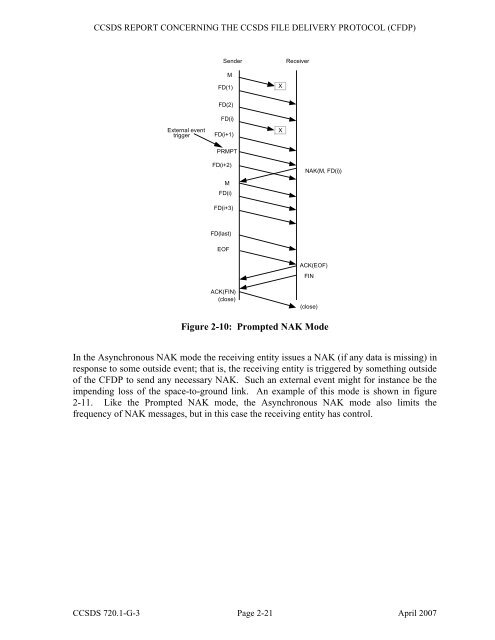CCSDS File Delivery Protocol (CFDP)âPart 1: Introduction and ...
CCSDS File Delivery Protocol (CFDP)âPart 1: Introduction and ...
CCSDS File Delivery Protocol (CFDP)âPart 1: Introduction and ...
You also want an ePaper? Increase the reach of your titles
YUMPU automatically turns print PDFs into web optimized ePapers that Google loves.
<strong>CCSDS</strong> REPORT CONCERNING THE <strong>CCSDS</strong> FILE DELIVERY PROTOCOL (<strong>CFDP</strong>)<br />
Sender<br />
Receiver<br />
M<br />
FD(1)<br />
X<br />
External event<br />
trigger<br />
FD(2)<br />
FD(i)<br />
FD(i+1)<br />
X<br />
PRMPT<br />
FD(i+2)<br />
NAK(M, FD(i))<br />
M<br />
FD(i)<br />
FD(i+3)<br />
FD(last)<br />
EOF<br />
ACK(EOF)<br />
FIN<br />
ACK(FIN)<br />
(close)<br />
(close)<br />
Figure 2-10: Prompted NAK Mode<br />
In the Asynchronous NAK mode the receiving entity issues a NAK (if any data is missing) in<br />
response to some outside event; that is, the receiving entity is triggered by something outside<br />
of the <strong>CFDP</strong> to send any necessary NAK. Such an external event might for instance be the<br />
impending loss of the space-to-ground link. An example of this mode is shown in figure<br />
2-11. Like the Prompted NAK mode, the Asynchronous NAK mode also limits the<br />
frequency of NAK messages, but in this case the receiving entity has control.<br />
<strong>CCSDS</strong> 720.1-G-3 Page 2-21 April 2007

















